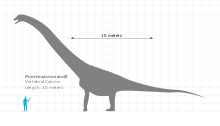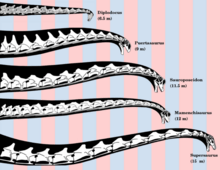Puertasaurus
| Puertasaurus Temporal range: Late Cretaceous (see text) | |
|---|---|
 | |
| Dorsal vertebra (right) compared with a vertebra of Argentinosaurus | |
| Scientific classification | |
| Kingdom: | Animalia |
| Phylum: | Chordata |
| Clade: | Dinosauria |
| Order: | Saurischia |
| Suborder: | †Sauropodomorpha |
| Clade: | †Sauropoda |
| Clade: | †Titanosauria |
| Clade: | †Lognkosauria |
| Genus: | †Puertasaurus Novas et al., 2005 |
| Type species | |
| Puertasaurus reuili Novas et al., 2005 | |
Puertasaurus is a genus of titanosaurian sauropod that lived during the Late Cretaceous. Its bones were recovered from the Pari Aike Formation, which is dated to be middle Cenomanian in age. It lived in what is now Patagonia. The type species, Puertasaurus reuili, is named in honor of Pablo Puerta and Santiago Reuil, who discovered the specimen in January 2001. Puertasaurus is based on a partial spinal column: a neck vertebra, a dorsal (back) vertebra, and two tail vertebrae.[1]
Anatomy
Of the four neck, back and tail vertebrae discovered, together forming the holotype MPM 10002, the largest is the back vertebra, measuring 1.06 metres (3 ft 6 in) tall and 1.68 metres (5 ft 6 in) wide. This is the broadest sauropod vertebra known, and two-thirds of its width is made up of the huge wing-like diapophyses (side processes which supported the ribs), which are heavily buttresed and merge with both the centrum and the neural spine, forming a wide spade-like shape. In most sauropods, like Argentinosaurus, they are far less large, lack buttresses, and form a simple cross-bar shape.[2][3]
Size

Fernando Novas, one of the paleontologists who described Puertasaurus reuili, estimated that the new species was approximately 35 to 40 metres (115 to 131 ft) long and weighed between 80 and 100 metric tons (88 and 110 short tons).[4] This would place it as one of the biggest dinosaurs ever to walk the earth, only rivaled in size by its relative Argentinosaurus. More recent reconstructions suggest a length of 30 metres (98 feet) and a weight of at least 50 metric tons (55 short tons).[5] Scott Hartman made a reconstruction that suggests a slightly shorter length of 27 metres (89 feet) and a total weight of 60–70 metric tons (66–77 short tons).[6]
Classification

Puertasaurus belonged to the clade Titanosauria.[1] It is a member of the group Lognkosauria, which includes the gigantic Futalognkosaurus and the somewhat smaller Mendozasaurus.[7]
Occurrence
Puertasaurus is from the Late Cretaceous of southern Patagonia. However, what lithologic unit it was derived from and its geological age have been disputed. It was originally reported as being from the Pari Aike Formation, and Maastrichtian in age.[1] These strata were subsequently reassigned to the Mata Amarilla Formation and reinterpreted as being from the Cenomanian to Santonian.[8] However, stratigraphic nomenclature of southern Patagonia is inconsistent, and these deposits actually pertain to the Cerro Fortaleza Formation, which dates to the Campanian or Maastrichtian.[9]
References
- 1 2 3 Novas, Fernando E.; Salgado, Leonardo; Calvo, Jorge; Agnolin, Federico (2005). "Giant titanosaur (Dinosauria, Sauropoda)from the Late Cretaceous of Patagonia" (PDF). Revisto del Museo Argentino de Ciencias Naturales, n.s. 7 (1): 37–41. Archived from the original (PDF) on August 22, 2006. Retrieved 2007-03-04.
- ↑ Kristina Curry Rogers,Jeffrey Wilson The Sauropods: Evolution and Paleobiology
- ↑ Sauropod basic vertebral anatomy
- ↑ Roach, J. (2006), "Giant Dinosaur Discovered in Argentina", National Geographic News, 28 July 2006. http://news.nationalgeographic.com/news/2006/07/060728-giant-dinosaur.html, accessed 23 May 2008.
- ↑ Paul, G.S., 2010, The Princeton Field Guide to Dinosaurs, Princeton University Press p. 206
- ↑ http://www.skeletaldrawing.com/home/2013/06/the-biggest-of-big.html
- ↑ Calvo, J. O.; Porfiri, J. D.; González Riga, B. J.; Kellner, A. W. A. (2007). "Anatomy of Futalognkosaurus dukei Calvo, Porfiri, González Riga, & Kellner, 2007 (Dinosauria, Titanosauridae) from the Neuquen Group, Late Cretaceous, Patagonia, Argentina" (PDF). Arquivos do Museu Nacional. 65 (4): 511–526. Archived from the original (PDF) on 2011-07-13.
- ↑ Varela, Augusto N.; Poiré, Daniel G.; Martin, Thomas; Gerdes, Axel; Goin, Francisco J.; Gelfo, Javier N.; Hoffmann, Simone (2012). "U-Pb zircon constraints on the age of the Cretaceous Mata Amarilla Formation, Southern Patagonia, Argentina: its relationship with the evolution of the Austral Basin". Andean Geology. 39 (3): 359–379. doi:10.5027/andgeoV39n3-a01.
- ↑ Lacovara, Kenneth J.; Ibiricu, L.M.; Lamanna, M.C.; Poole, J.C.; Schroeter, E.R.; Ullmann, P.V.; Voegele, K.K.; Boles, Z.M.; Egerton, V.M.; Harris, J.D.; Martínez, R.D.; Novas, F.E. (September 4, 2014). "A Gigantic, Exceptionally Complete Titanosaurian Sauropod Dinosaur from Southern Patagonia, Argentina". Scientific Reports. 4: 6196. doi:10.1038/srep06196. PMC 5385829. PMID 25186586.